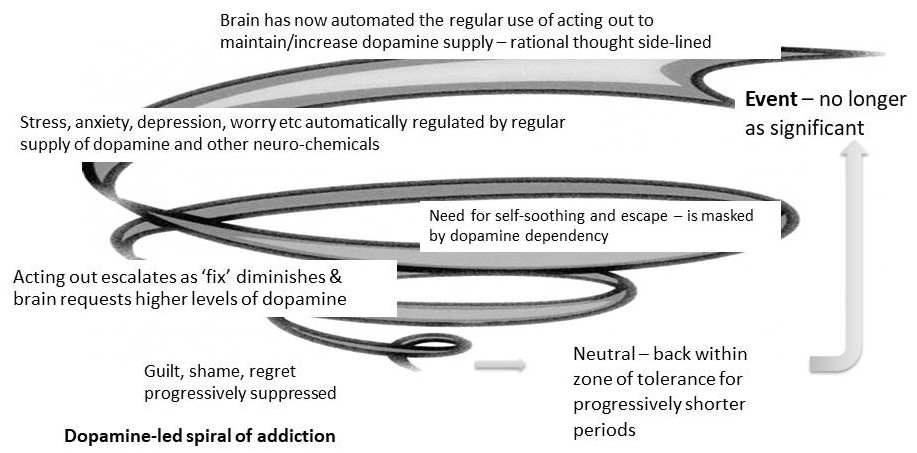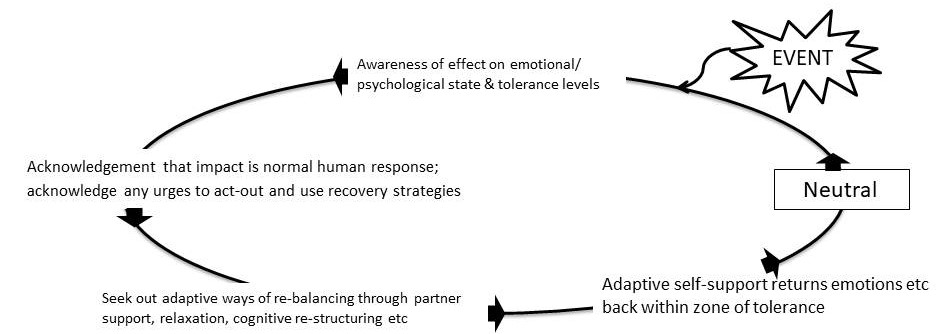Free Resources for Sex and Porn Addiction – Module 3

Free Resources for Sex and Porn Addiction - Module 3
The Grip of Dopamine-Led Addiction; Regaining Power over Cravings – 5 Essential Simple Steps
This module ends with 5 essential yet simple do-right-now steps you can take to begin winding back the automated dopamine effect and resume manual control.
Dopamine-led cycle of addiction
Addiction as a Learned Behaviour

- The often complete lack of conscious control and feeling of powerlessness when the sensitised brain triggers off and cravings tug – a sort of euphoric impulsiveness shuts off any rational decision-making
- The deceptive feeling that addiction is genetic or a given – therefore incurable; the ‘automated’ pathways feel more like an in-built trait rather than a learned behaviour
- The obsessive searching for the perfect image, chat-room exchange or sexual encounter to meet the escalating dopamine expectations becomes more important than climax and explains long durations of acting out, edging and delaying climax to maintain pain-numbing euphoria
- Escalation of the behaviours into more and more risky and sometimes illegal activities as the de-sensitisation sets in and extreme acting out stealthily takes hold, over-riding an addict’s personal values and ethics.
Recovery Journey Map
- Disrupting and then switching off the automated, pre-conscious dependency on dopamine (this returns you to the type 1 behavioural spiral) – sometimes referred to as over-learning, the re-boot or rewiring period
- Resolution of any underlying pre-conditioning, crunch-point experiences and chronic factors (see Module 2 – Causal Patterns) that give dysfunctional responses to life events (this is done at the same time as 1 and may involve psychotherapy, EMDR, coaching etc.)
- Installation of a virtuous cycle of self-support to maintain well-being and ward-off any need for acting out as an escape – usually done using coaching support or self-help techniques (see Module 5).

Virtuous Cycle of Self-Support – the Final Destination

Get Started on Stage 1 – Disrupting and Switching off the Spiral of Dopamine Dependency
Select either
a) I am starting right now with complete abstinence from acting out OR
b) I will de-escalate acting out
Now set a Timeframe
Complete – “I am committing to total abstinence from acting out from today (date _________) or following a period of de-escalation I will begin total abstinence from (date __________)”
I am aiming at achieving 90 days total abstinence from acting out on the (date) _________________
In the red STOP light HIGH RISK zone write down all of those acting out behaviours you aim to end for good and from now on are classed as totally prohibited ‘No Go’ activities. (see Figure 5: Traffic Light Re-Wiring Plan)
In the red STOP light LOW RISK zone write down any activities that are potential gateways and slippery slopes leading to the high risk STOP behaviours. These may possibly be resumed once the re-wiring has completed but present a current risk whilst in early abstinence. (examples include places, social media, adult TV and films, alcohol use, events associated with the addictive rituals and so on)
In the green GO light MORE OF zone write down any healthy sexual activities important to your well-being (such as sex with partner) and in the green GO NEEDS WORK zone write down any sexual or relational activities that you need to resurrect, increase or improve (intimacy/talking more, more romance or spontaneous sexual fun with partner, for example).
In the amber CAUTION light write down any activities or triggers where the risk to abstinence is as yet untested. For example, solo masturbation, fantasy or being with a particular person. For some addicts these are manageable so that they are not gateways whereas for others they are too risky and best avoided. Sometimes couple sex and solo masturbation can be risk factors due to the ‘chaser’ effect when the dopamine spiral triggers you into wanting more. Exert caution and monitor your reactions carefully!

Figure 5: Traffic Light Re-Wiring Plan
Instant disruption to the dopamine auto-dependency can be achieved by stripping out access to the internet and phone-based apps so that people, porn or escort pages for example can’t be accessed. List here how you will control devices, apps and internet access (i.e. pass codes, parental settings, blocking apps etc.).
Now write down any other environmental controls that will disrupt your habituated acting out ritual (changes to daily routine to avoid time alone, changing the route/transportation to and from work, going to bed earlier, using down-time to exercise and so on are good example)
Practice more self-monitoring of your mind states so that you can become aware of when your dopamine thermostat is switching on. Notice how effective you are and the progress you make as you disrupt the automated ritual of acting out. Keep one step ahead of the auto-pilot and stay mentally in control by constantly planning ahead and prioritising your goals, traffic lights, and controls.
Acknowledge cravings and roll with them, continuing your new routines, rather than fight head-on. Focus on, and become dedicated to, making changes to your routines to disrupt the habituated pathways in your brain. Avoid fixating on stopping so that feelings of powerlessness are kept at bay.
Reward accomplishment. Your brain needs to learn new and healthy automated routines by linking your wins with pleasurable pay-offs and benefits. Find ways to positively reinforce periods of daily or weekly abstinence such as meals out, socialising, indulging your healthy pursuits, relaxation, cinema trips or buying new books/DVDs/music etc.
Here are two tips I have learned from clients that work really effectively for them. When struggling, quickly put on your jacket and go for a walk. To help re-train the brain do what I call the 5,000 step challenge – walk 2,500 paces then turn round and count back from 2,500 reaching 0 when you get home! You will be amazed at the level of concentration this takes and also benefit from healthy doses of happy chemicals. Secondly, begin learning a challenging new hobby or skill which you can immerse yourself in such as juggling, cycling/running, playing the keyboard, model-making or wood-turning. Creativity and challenge are perfect ways to re-direct your neural pathways and feel good by achieving a sense of ‘flow’. (see Module 4 for more on this)
In the next module, V2V 4 we will be looking at a highly effective toolkit for managing cravings and urges.
